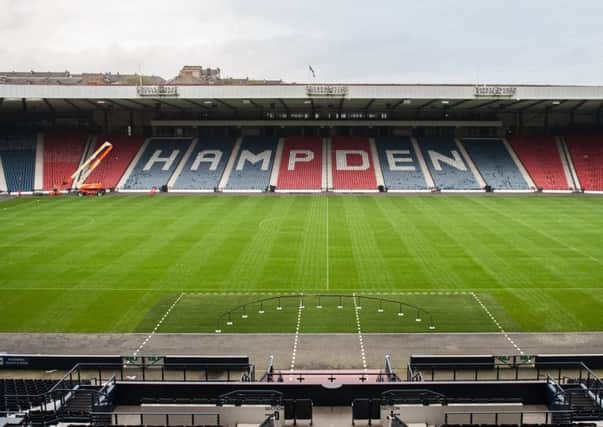Scotland's options if the SFA decide to ditch Hampden Park


With eye-watering business rate rises set to affect companies all over the country, the home of Scottish football is no exception.
Advertisement
Hide AdAdvertisement
Hide AdAn annual increase on the bill paid by Hampden Parks owners of £350,000 has sparked speculation on whether the game’s custodians might seek a new abode.
The national stadium has often been maligned for a perceived lack of natural atmosphere and the partial running track that leaves fans behind both goals feeling removed from the action.
The lease on the ground is set to expire in 2020, and the SFA have already entertained the idea that they may depart the famous stadium.
If they do, here are some of the places they could go.
Celtic Park
Scotland’s biggest football stadium, by capacity, the home of the Scottish champions might seem like the most obvious option for Scotland games.
The famous European fixtures that Parkhead has hosted over the years give a flavour of what kind of big-game atmosphere Scotland could expect if they move to the East End.
Celtic Park has actually hosted more competitive Scotland fixture than any stadium bar Hampden, most recently a famous 1-0 victory over the Republic of Ireland.
A potential drawback is the colour scheme. The green seats and livery of Celtic Park are of course appropriate for their main tenants, but don’t quite suit the traditional dark blue colour of the Scotland national side.
Ibrox
The other side of the Old Firm divide, Rangers’ home ground meets the UEFA 5-star stadium requirements, which gives it an edge over Celtic Park.
Advertisement
Hide AdAdvertisement
Hide AdIt is also well served by transport links, and it too can produce a famous atmosphere on its day – with stands that are close to the pitch.
The traditional blue that adorns the Ibrox seats is also more amenable to Scotland’s colours than that of their great city rivals.
But with 50,000 seats, Ibrox wouldn’t offer an attendance boost relative to the current stadium, which could be a drawback for big games.
Murrayfield
Picking either of the Old Firm for a national stadium has significant problems. It could affect attendances with fans of some teams refusing to go to the homes of Celtic and Rangers.
It would also complicate cup finals, if, for example, Celtic are in the Scottish Cup final, and the tie is at Celtic Park, many would insist that is unfair.
So we look to another coast, and Scotland’s biggest stadium.
Murrayfield might be best known as the home of rugby, but it has hosted football matches before, most recently two Celtic Champions League qualifiers in 2014.
While Scotland are in the minority of teams that don’t play in their nation’s capital, many fans have got used to Glasgow as the biggest and best city for football.
Advertisement
Hide AdAdvertisement
Hide AdThe Tartan Army may be reluctant to move to Edinburgh, and a stadium designed for a different sport.
A new stadium
Maybe it’s time to give up Hampden as a bad job – the distance from the pitch and the relatively poor transport links might just be too great an issue to continue to ignore.
But where would it be?
The head of Event Scotland had a novel idea in 2014. Why not, he asked, put a new football and rugby stadium between Glasgow and Edinburgh?
It was thought that the new stadium could be on any number off sites off the M8, the main route between Scotland’s two biggest cities.
However, it is an idea unlikely to gain much traction. Football and rugby fans would be reluctant to accept a new arena in Harthill or Falkirk, and a shared stadium has its own obvious drawbacks.
No fixed abode
A number of the world’s most successful football nations don’t have a permanent home for their national team.
Spain, Italy and Germany are among World Cup winners who have decided to move about their respective countries, and Scotland could easily do the same.
A version of this model already exists in Scotland, as we tend to play games of lesser importance at smaller venues (Scotland’s next game, a friendly against Canada, will take place at Easter Road).
Being a touring side might not be the reason why these sides are so successful, but that doesn’t mean it isn’t worth a try.